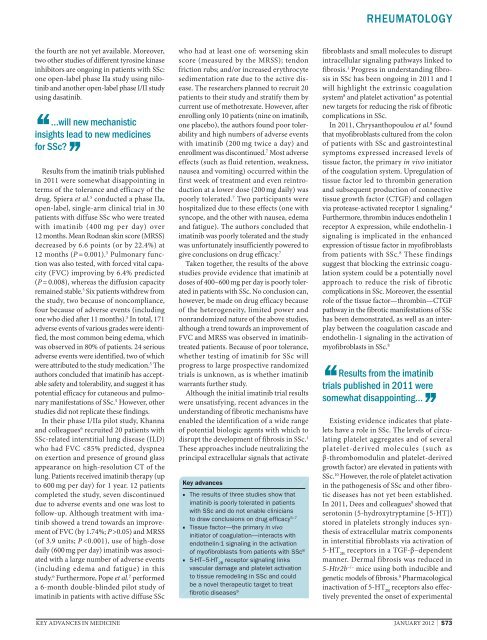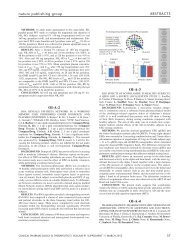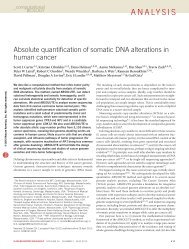open access: Nature Reviews: Key Advances in Medicine
open access: Nature Reviews: Key Advances in Medicine
open access: Nature Reviews: Key Advances in Medicine
Create successful ePaper yourself
Turn your PDF publications into a flip-book with our unique Google optimized e-Paper software.
the fourth are not yet available. Moreover,<br />
two other studies of different tyros<strong>in</strong>e k<strong>in</strong>ase<br />
<strong>in</strong>hibitors are ongo<strong>in</strong>g <strong>in</strong> patients with SSc:<br />
one <strong>open</strong>-label phase IIa study us<strong>in</strong>g nilot<strong>in</strong>ib<br />
and another <strong>open</strong>-label phase I/II study<br />
us<strong>in</strong>g dasat<strong>in</strong>ib.<br />
‘‘ …will new mechanistic<br />
<strong>in</strong>sights lead to new medic<strong>in</strong>es<br />
for SSc?<br />
’’<br />
Results from the imat<strong>in</strong>ib trials published<br />
<strong>in</strong> 2011 were somewhat disappo<strong>in</strong>t<strong>in</strong>g <strong>in</strong><br />
terms of the tolerance and efficacy of the<br />
drug. Spiera et al. 5 conducted a phase IIa,<br />
<strong>open</strong>-label, s<strong>in</strong>gle-arm cl<strong>in</strong>ical trial <strong>in</strong> 30<br />
patients with diffuse SSc who were treated<br />
with imat<strong>in</strong>ib (400 mg per day) over<br />
12 months. Mean Rodnan sk<strong>in</strong> score (MRSS)<br />
decreased by 6.6 po<strong>in</strong>ts (or by 22.4%) at<br />
12 months (P = 0.001). 5 Pulmonary function<br />
was also tested, with forced vital capacity<br />
(FVC) improv<strong>in</strong>g by 6.4% predicted<br />
(P = 0.008), whereas the diffusion capacity<br />
rema<strong>in</strong>ed stable. 5 Six patients withdrew from<br />
the study, two because of non compliance,<br />
four because of adverse events (<strong>in</strong>clud<strong>in</strong>g<br />
one who died after 11 months). 5 In total, 171<br />
adverse events of various grades were identified,<br />
the most common be<strong>in</strong>g edema, which<br />
was observed <strong>in</strong> 80% of patients. 24 serious<br />
adverse events were identified, two of which<br />
were attributed to the study medication. 5 The<br />
authors concluded that imat<strong>in</strong>ib has acceptable<br />
safety and toler ability, and suggest it has<br />
potential efficacy for cutaneous and pulmonary<br />
manifestations of SSc. 5 However, other<br />
studies did not replicate these f<strong>in</strong>d<strong>in</strong>gs.<br />
In their phase I/IIa pilot study, Khanna<br />
and colleagues 6 recruited 20 patients with<br />
SSc-related <strong>in</strong>terstitial lung disease (ILD)<br />
who had FVC 0.05) and MRSS<br />
(of 3.9 units; P








